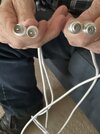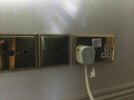Just going down the points in order
1 - understood, but it doesn't help us so we'll move on
2 - encouraging (& RIP)
3 - pictures help greatly, thanks. See below
4 - you won't find the screw type. It looks like previous occupier installed an aerial distribution system rather than aerial and satellite. That's not a bad thing actually because Sat signal distribution doesn't work in the same way as aerial distribution. It simplifies things
5 - see below
Those brass faceplates, the one picture left with two sockets, that's a TV and Radio wall plate. I'm not going to deal with radio at this point other than to acknowledge that it's the type of plate. What you're missing (or at least appears missing from the photo) is the labelling on the sockets that tells you which signals out of what sockets.
View attachment 284273
The left-hand socket is the one for TV. The receptacle end on the wall plate is a male. That means you either need a cable that's female to male, or you need what's known as a gender changer - a back-to-back / cable joiner / coupler adapter - on a male to male lead.
The cables that you have both appear to be male-to-male. The plug ends picture left are the type used with moulded cables. The plug ends picture right appear to be the plug type you'd buy loose and use as a DIY fit to your own cable. I know it's got holes in the centre post ends but that's how they're made so that the centre core can poke through and be soldered in place. (Incidentally, the cable in both examples appears to be the thin and poorly shielded extension type sold by Argos / DIY sheds / supermarkets.)
If one of the cables is female to female then you'll be able to link the two together daisy-chain fashion, but I suspect they won't do (don't force them) because they're both male.
The immediate fix is a coax gender changer.
View attachment 284274
https://www.screwfix.com/p/labgear-coaxial-couplers-10-pack/26904
If your system doesn't work after this then it's because you're missing a power supply for the amplified splitter/diplexer. We'll cross that bridge when we come to it.
Longer-term you could do with some proper coax fly leads made with good shielded cable, and correctly terminated for the wall plate to TV connections you have. You won't get these off-the-shelf unless you pay through the nose for 'premium' cables in blister packs. I've seen prices ranging from £20 - £30 for a simple fly lead, and even then I'm not convinced how long they'll last.
There's a few of us here in the trade who can make cables to order - white or black all-copper coax cable - and at a fraction of the price. Drop us a message.



